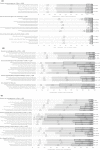Development of parallel measures to assess HIV stigma and discrimination among people living with HIV, community members and health workers in the HPTN 071 (PopART) trial in Zambia and South Africa
- PMID: 31840400
- PMCID: PMC6912047
- DOI: 10.1002/jia2.25421
Development of parallel measures to assess HIV stigma and discrimination among people living with HIV, community members and health workers in the HPTN 071 (PopART) trial in Zambia and South Africa
Abstract
Introduction: Integrating standardized measures of HIV stigma and discrimination into research studies of emerging HIV prevention approaches could enhance uptake and retention of these approaches, and care and treatment for people living with HIV (PLHIV), by informing stigma mitigation strategies. We sought to develop a succinct set of measures to capture key domains of stigma for use in research on HIV prevention technologies.
Methods: From 2013 to 2015, we collected baseline data on HIV stigma from three populations (PLHIV (N = 4053), community members (N = 5782) and health workers (N = 1560)) in 21 study communities in South Africa and Zambia participating in the HPTN 071 (PopART) cluster-randomized trial. Forty questions were adapted from a harmonized set of measures developed in a consultative, global process. Informed by theory and factor analysis, we developed seven scales, with values ranging from 0 to 3, based on a 4-point agreement Likert, and calculated means to assess different aspects of stigma. Higher means reflected more stigma. We developed two measures capturing percentages of PLHIV who reported experiencing any stigma in communities or healthcare settings in the past 12 months. We validated our measures by examining reliability using Cronbach's alpha and comparing the distribution of responses across characteristics previously associated with HIV stigma.
Results: Thirty-five questions ultimately contributed to seven scales and two experience measures. All scales demonstrated acceptable to very good internal consistency. Among PLHIV, a scale captured internalized stigma, and experience measures demonstrated that 22.0% of PLHIV experienced stigma in the community and 7.1% in healthcare settings. Three scales for community members assessed fear and judgement, perceived stigma in the community and perceived stigma in healthcare settings. Similarly, health worker scales assessed fear and judgement, perceived stigma in the community and perceived co-worker stigma in healthcare settings. A higher proportion of community members and health workers reported perceived stigma than the proportion of PLHIV who reported experiences of stigma.
Conclusions: We developed novel, valid measures that allowed for triangulation of HIV stigma across three populations in a large-scale study. Such comparisons will illuminate how stigma influences and is influenced by programmatic changes to HIV service delivery over time.
Trial registration: ClinicalTrials.gov NCT01900977.
Keywords: HIV; Sub-Saharan Africa; antiretroviral therapy; discrimination; measurement; stigma.
© 2019 The Authors. Journal of the International AIDS Society published by John Wiley & Sons Ltd on behalf of the International AIDS Society.
Figures

References
-
- Stirratt MJ, Gordon CM. Adherence to biomedical HIV prevention methods: Considerations drawn from HIV treatment adherence research. Curr HIV/AIDS Rep. 2008;5(4):186–92. - PubMed
Publication types
MeSH terms
Associated data
Grants and funding
LinkOut - more resources
Full Text Sources
Medical
Miscellaneous

